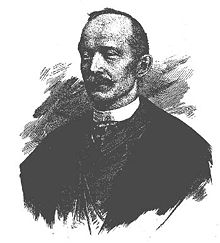| Arthur Vierendeel | |
|---|---|
 | |
| Born | 10 April 1852 Leuven, Belgium |
| Died | 8 November 1940 |
Arthur Vierendeel (10 April 1852 – 8 November 1940) was a civil engineer born in Leuven, Belgium. He had a career as a university professor, and civil engineer. The structure known as the Vierendeel truss is named after him.
Biography
He obtained an MSc in construction and mining engineering in 1874 at the Université catholique de Louvain, after which he worked as an engineer for the company Nicaise et Delcuve in La Louvière, Belgium. In 1885 he became Director for the Ministry of Public Works in West Flanders, and four years afterward also achieved the post of Professor of Construction, Material Strength, and Structural Engineering at the Université catholique de Louvain.
The idea of a bridge without trusses came to him in 1895; the design later became known as a Vierendeel bridge. For the 1897 World Fair at Brussels he built a 31.5m span bridge at his own expense and loaded to show the correlation between measurement and his numerical analysis.
His work, Cours de stabilité des constructions (1889) was an important reference during more than half a century. His first bridge was built in Avelgem in 1902, crossing the Scheldt river. The construction of this bridge became famous through the Stijn Streuvels book De Teloorgang van de Waterhoek.
He retired as director of public works in West Flanders in 1927, and as Professor at Leuven Catholic University in 1936. He died in 1940.
Legacy
The Vierendeel truss was used in Belgium, particularly on the Belgian railways. Discussions in the journal Der Eisenbau concerning the pros and cons of the Vierendeel truss led to the development of deformational modelling of structures - necessary for mathematical analysis of Vierendeel trusses.
He emphasised an importance of aesthetics over pure engineering:
Pour les constructions métalliques les dimensions doivent être déterminées à priori par des considérations esthétiques et qu’après seulement il y a lieu de recourir à la formule mathématique. (When constructing in metal the dimensions must be determined a priori by aesthetic considerations and only afterwards should mathematical formulas be used)
— A. Vierendeel
As of 2011 the castellated beam and cellular beam are in common use in construction for roof and floor support - both are open web structures without diagonal trusses; vierendeel truss type analysis is used to understand and predict failure modes, which include vierendeel truss type failures.
See also
References
- ^ Karl-Eugen Kurrer (2002). Geschichte der Baustatik. Ernst & Sohn. p. 494. ISBN 9783433016411.
- Lyne Fontaine; Stephen J. Kelly; Randolph Langenbach; Claudio Modena; Michael Pittas; Heinrich Schroeter; S. Patrick Sparks; David Yoemans (4 October 2009). "Open letter on the demolition of the Scheepsdale Bridge". scribd.com. Flemish Historic Buildings Department / The International Scientific Committee on the Analysis and Restoration of Structures of Architectural Heritage (ISCARSAH) / International Council on Monuments and Sites (ICOMOS).
- Koen Verswijver; Ronald De Meyer; Rudi Denys; Emiel De Kooning (May 2009). "The Writings of Belgian Engineer Arthur Vierendeel (1852–1940): Homo Universalis or Contemporary Propagandist?". Proceedings of the Third International Congress on Construction History: 1463–1470. Archived from the original on 6 October 2011.
- Buick Davison; Graham W. Owens (2005). Steel designers' manual. John Wiley and Sons. pp. 458–460.
- Jean-marc Franssen (2010). Structures in Fire: Proceedings of the Sixth International Conference. DEStech Publications, Inc. pp. 100–101. ISBN 9781605950273.
External links
- Patricia Radelet-de Grave. "Ingenieurporträt: (Jules) Arthur Vierendeel; Erfinder des Trägers ohne Diagonalen" (PDF). db-bauzeitungd.de (in German). deutsche bauzeitung. Archived from the original (PDF) on 21 March 2012.
- Karel Roose. "Vierendeel bruggen". users.telnet.be (in Dutch). (Vierendeel bridges, publications and other information)
- Representing structure. Reflections on the work of Arthur Vierendeel "La construction architecturale en fonte, fer et acier" Paper written by Isaac López César and Javier Estévez Cimadevila.